“Why don’t youse punters leave the ankle-biters in the big smoke and bail to the Top End to squizz at some beaut chooks like bushman’s clocks and those shiny gizmos?” Oops, I forgot that this post needs to written in English and not in Australian so I’ll try that again. “Why don’t you folks leave the kids at home and come to the Northern Territory to see some cool birds like kookaburras and Rainbow Pittas?” Ok, I know. For most people, a trip to Australia means a pretty substantial investment, both time and money-wise. But its seriously worth it. Here’s a brief glimpse into our search for Rainbow Pittas in the land Down Under during the filming of Nikon’s BATV Australia series.
Pittas, whether they be common or rare, are amongst the most wanted and enigmatic birds on earth. Gurney’s Pitta for example, a particularly rare pitta species, is at the top of the list for most birders visiting Thailand. On the other hand, Rainbow Pittas are fairly common in the monsoon forests of the Top End of the Northern Territory. But they are one of Australia’s most sought-after species on account of their stunning coloration and limited distribution.
The Top End of the Northern Territory is the second northernmost point on the continent. It comprises a vaguely defined area that is situated above the arid and better-known Red Centre to the south. The Top End includes the city of Darwin and the iconic national parks of Kakadu and Litchfield. Birding here is something straight out of Crocodile Dundee, an exciting blend of danger and diversity. This is sufficiently illustrated by the fact that any significant water-body is a magnet for both saltwater and freshwater crocs and places like Fogg Dam are famed for holding up to a ton of snakes per square kilometer! But don’t worry. Thanks to well-maintained national parks and good roads, you don’t have to wade through perilous waters to view birds. Well, you can…but then you might be better off saving some cash and buying a one-way ticket in lieu of a return flight.
Before we headed off to search for pittas we made a detour to a wonderful birding spot close to Darwin. Buffalo Creek is a really great introduction to the birds of the Top End. Early mornings here are phenomenal with Figbirds, various friarbird species, kingfishers, parrots and pigeons in abundance. Birding the forested edges of the road down to the creek itself can be very productive. The creek has excellent stands of mature mangroves where Chestnut Rails sometimes make an appearance at low tide and a walk to the mouth reveals sandy beaches that hold some nice shorebirds.
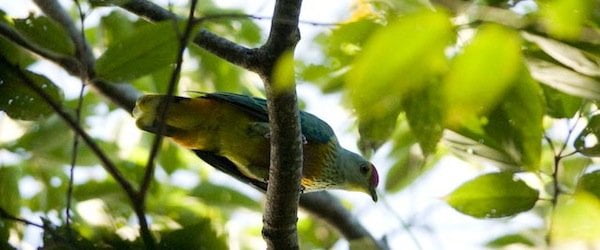 Rose-crowned Fruit-Dove in the canopy
Rose-crowned Fruit-Dove in the canopy
Whilst Rainbow Pittas can be reliably found at Kakadu National Park, there are locations closer to Darwin and even in Darwin itself, where the birds can be found with a little bit of effort and patience. One such place is Fogg Dam Conservation Reserve, a failed rice project that is now a phenomenal birding spot with excellent aquatic species and some extensive patches of really nice monsoon forest. Whilst driving to Fogg Dam – or whilst driving anywhere in the Top End in fact – it is a good idea to keep an eye out for some of the area’s iconic reptiles. Watch for Mertens’ Water Monitors at bridges and look for the famed Frilled Lizards, particularly around stands of eucalyptus trees.
httpvh://www.youtube.com/watch?v=tWogscF460U
Fogg Dam lies on a tributary of the Adelaide River in a huge meandering floodplain. The wet season runs from November through to March and at the end of the wet season water flows steadily over the causeway in the middle of the dam. Hundreds of wading birds and waterfowl accumulate here to take advantage of the fish and other tasty morsels that get swept over in the shallow water. Jabiru Storks, Magpie Geese, Royal Spoonbills, Burdekin Ducks, Rufous Night-herons and a nice variety of egrets and cormorants are always in attendance. There is also a good diversity of mammals here although they are definitely harder to see. Dingos are fairly common in the area, and night-time can reveal smaller mammals like northern brown bandicoots, various rodent species, and small planigales (carnivorous marsupials).
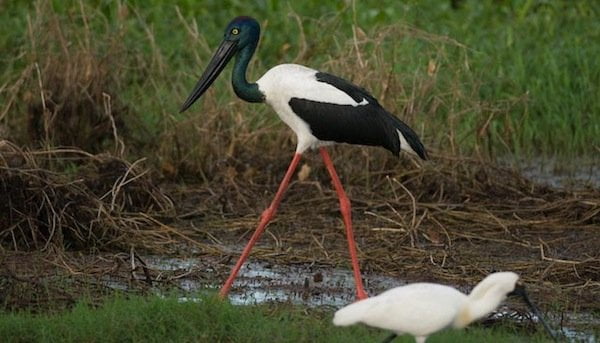 A Jabiru walks behind a Royal Spoonbill at Fogg Dam
A Jabiru walks behind a Royal Spoonbill at Fogg Dam
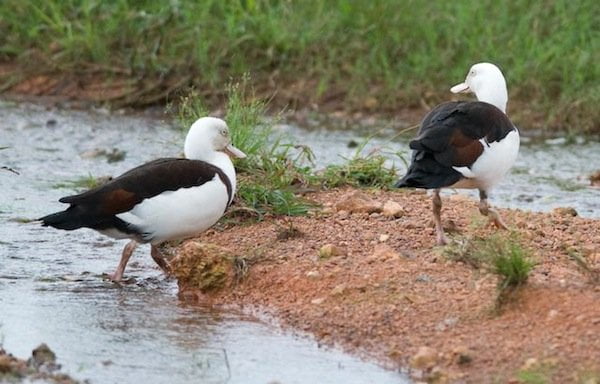 Burdekin Ducks are just one of a handful of waterfowl species
Burdekin Ducks are just one of a handful of waterfowl species
The area around the dam itself comprises of pristine monsoon forest habitat, flanked by eucalyptus forest and also paperbark forest. The monsoon forest is in great condition here, with towering fig trees and the constant sound of birdsong. Oriental Cuckoos perch prominently at the forest edge, Little Kingfishers shoot past like tiny blue and white arrows, Blue-winged Kookaburras laugh hysterically at us birders and Bush Thick-knees peer warily from secondary growth at the forest fringe. Rainbow Pittas can be found along the trails that run through the monsoon forest but its tough to get good views of them. And even harder to film the little blighters!
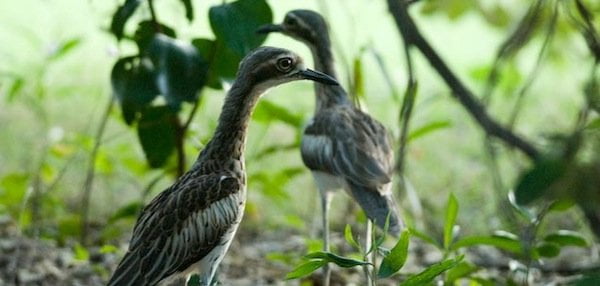 A pair of Bush Thick-knees shelter in the forest fringes
A pair of Bush Thick-knees shelter in the forest fringes
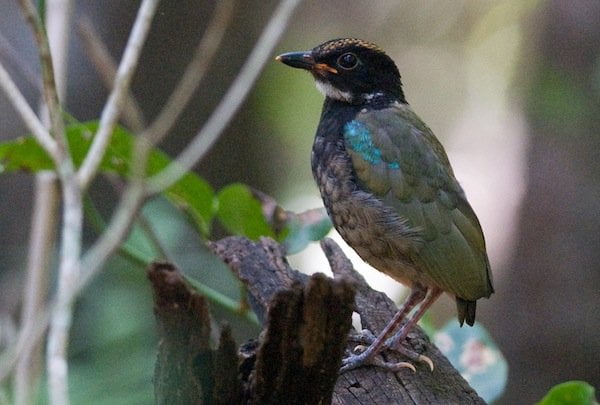 A juvenile Rainbow Pitta tempted us before we found the adults
A juvenile Rainbow Pitta tempted us before we found the adults
We literally spent several days trying to film over 30 different Rainbow Pitta individuals but the thick undergrowth and nervous pittas made for an incredibly aggravated cameraman. Not a birder by choice, excessive birding makes Aderman nuts and, at 6ft 8 in height, he’s not the most nimble of cameramen in the tangled underbrush of monsoon forest! Even to this day he refuses to call them by their proper name, preferring instead a barrage of specific expletives as prefixes to the generic word “pitta”. But what Aderman lacks in social graces and language, he more than makes up for in persistence. And we finally got a few to sit still long enough to capture them on film…
httpvh://www.youtube.com/watch?v=0B12TyqbyRI
So if you’re heading to Australia, try make a stop at the Top End. But please don’t curse at the poor pittas. They’ve taken enough abuse from foreign cameramen.
Photos by Mike Freiberg


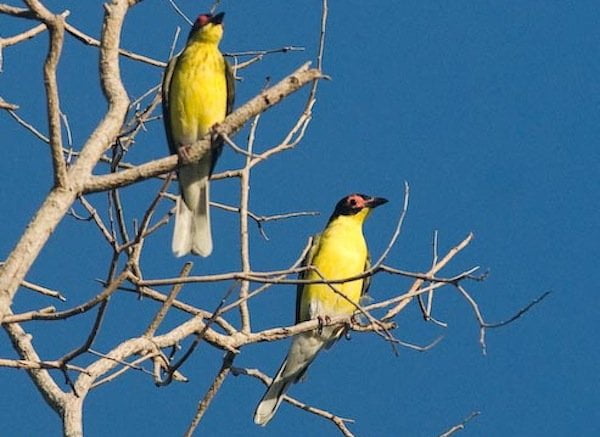











Between this post, having just finished reading The Jewel Hunter, and seeing Dale’s post about Gurney’s Pitta I am on pitta overload and ready to go to Africa, Asia, and Australia. Who’s willing pay my expenses?
Great video and tell Aderman thanks!
Frankly, Corey, what is required is a Brit to get out and see these things – you stick to birding SAmerica and I’ll do Australia, Asia and Africa.
Heard Rainbow Pitta once but never saw it, darn it. *sigh*
I just finished “The Jewel Hunter”, too – really a nice book about Pittas. Wish I could go to some of these places, too
ehm, just a question: Is Jabiru the right name for the stork shown in the third picture from top? I thought, Jabiru is only the name for a species in Central and South America. Shouldn’t it be a Black-necked Stork?
You’re correct Dan – Jabiru is the colloquial name for the bird in Australia. Black-necked Stork is the official common name although some of the older guide books still refer to the species as Jabiru.
Thank you for the explanation, James. That’s interesting: Are there any ideas, why two storks separated by thousands of kilometers had the same name? And which got its name first?
Some reference “jabiru” as having Aboriginal origins and meaning “stork”. Others suggest it comes from the Tupian languages of South America with the meaning “Swollen neck”. So I guess we’re no closer to finding the answer but perhaps someone else can shed more light?
nice job
PITTAS MAKE ME CRAAAZZZZYYYY!!!!!
Those Figbirds are really interesting looking, is that bare skin on the face? Great account by the way, the Big Smoke is on my destination wish list thanks to you.
Yes it is bare skin. Figbirds are cool birds.
Cool indeed, they almost look like a yellow Capuchin Bird with a hot temper.
Hi,
Is a rainbow pitta a hooded pitta?
@Sara: No Sara, Hooded Pittas are a different species. They look similar but only have black on the head, rather than the whole belly.
Thanks James!
Howard Springs nature park, 30 minutes south of Darwin is reliable for Rainbow Pitta. There is a short walking trail through monsoon forest in the park. In the breeding season RP is frequently seen along the track. Best wishes. Jenny
Just a smiling visitor here to share the love (:, btw outstanding layout. “Forget regret, or life is yours to miss.” by Jonathan Larson.